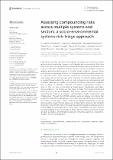| dc.contributor.author | Schlosser, C. Adam | |
| dc.contributor.author | Frankenfeld, Cypress | |
| dc.contributor.author | Eastham, Sebastian | |
| dc.contributor.author | Gao, Xiang | |
| dc.contributor.author | Gurgel, Angelo | |
| dc.contributor.author | McCluskey, Alyssa | |
| dc.contributor.author | Morris, Jennifer | |
| dc.contributor.author | Orzach, Shelli | |
| dc.contributor.author | Rouge, Kilian | |
| dc.contributor.author | Paltsev, Sergey | |
| dc.contributor.author | Reilly, John | |
| dc.date.accessioned | 2023-12-22T15:27:37Z | |
| dc.date.available | 2023-12-22T15:27:37Z | |
| dc.date.issued | 2023-04-24 | |
| dc.identifier.issn | 2624-9553 | |
| dc.identifier.uri | https://hdl.handle.net/1721.1/153234 | |
| dc.description.abstract | Physical and societal risks across the natural, managed, and built environments are becoming increasingly complex, multi-faceted, and compounding. Such risks stem from socio-economic and environmental stresses that co-evolve and force tipping points and instabilities. Robust decision-making necessitates extensive analyses and model assessments for insights toward solutions. However, these exercises are consumptive in terms of computational and investigative resources. In practical terms, such exercises cannot be performed extensively—but selectively in terms of priority and scale. Therefore, an efficient analysis platform is needed through which the variety of multi-systems/sector observational and simulated data can be readily incorporated, combined, diagnosed, visualized, and in doing so, identifies “hotspots” of salient compounding threats. In view of this, we have constructed a “triage-based” visualization and data-sharing platform—the System for the Triage of Risks from Environmental and Socio-Economic Stressors (STRESS)—that brings together data across socio-environmental systems, economics, demographics, health, biodiversity, and infrastructure. Through the STRESS website, users can display risk indices that result from weighted combinations of risk metrics they can select. Currently, these risk metrics include land-, water-, and energy systems, biodiversity, as well as demographics, environmental equity, and transportation networks. We highlight the utility of the STRESS platform through several demonstrative analyses over the United States from the national to county level. The STRESS is an open-science tool and available to the community-at-large. We will continue to develop it with an open, accessible, and interactive approach, including academics, researchers, industry, and the general public. | en_US |
| dc.language.iso | en_US | |
| dc.publisher | Frontiers Media SA | en_US |
| dc.relation.isversionof | 10.3389/fclim.2023.1100600 | en_US |
| dc.rights | Creative Commons Attribution | en_US |
| dc.rights.uri | https://creativecommons.org/licenses/by/4.0/ | en_US |
| dc.source | Frontiers Media SA | en_US |
| dc.subject | Management, Monitoring, Policy and Law | en_US |
| dc.subject | Atmospheric Science | en_US |
| dc.subject | Pollution | en_US |
| dc.subject | Environmental Science (miscellaneous) | en_US |
| dc.subject | Global and Planetary Change | en_US |
| dc.title | Assessing compounding risks across multiple systems and sectors: a socio-environmental systems risk-triage approach | en_US |
| dc.type | Article | en_US |
| dc.identifier.citation | Schlosser CA, Frankenfeld C, Eastham S, Gao X, Gurgel A, McCluskey A, Morris J, Orzach S, Rouge K, Paltsev S and Reilly J (2023) Assessing compounding risks across multiple systems and sectors: a socio-environmental systems risk-triage approach. Front. Clim. 5:1100600. | en_US |
| dc.contributor.department | Massachusetts Institute of Technology. Joint Program on the Science & Policy of Global Change | |
| dc.contributor.department | Massachusetts Institute of Technology. Laboratory for Aviation and the Environment | |
| dc.eprint.version | Final published version | en_US |
| dc.type.uri | http://purl.org/eprint/type/JournalArticle | en_US |
| eprint.status | http://purl.org/eprint/status/PeerReviewed | en_US |
| dspace.date.submission | 2023-12-22T15:24:27Z | |
| mit.journal.volume | 5 | en_US |
| mit.license | PUBLISHER_CC | |
| mit.metadata.status | Authority Work and Publication Information Needed | en_US |
